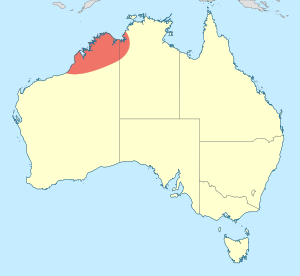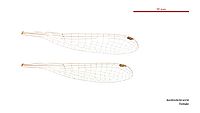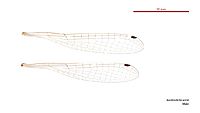Kimberley pondsitter facts for kids
Quick facts for kids Kimberley pondsitter |
|
|---|---|
| Scientific classification | |
 |
Austrosticta soror, commonly known as the Kimberley pondsitter, is a special kind of damselfly. Damselflies are small, delicate insects that are related to dragonflies. You can often tell them apart because damselflies usually hold their wings together over their back when they are resting, while dragonflies hold theirs out to the sides.
This particular damselfly is found only in one place: the Kimberley region of Western Australia. When an animal or plant is found only in one specific area, we say it is endemic to that place. The Kimberley pondsitter likes to live near ponds and streams, especially those found in deep gorges.
What is the Kimberley Pondsitter?
The Kimberley pondsitter is a medium-sized damselfly. It usually has a dull, dark color. This helps it blend in with its surroundings near the water.
Like all damselflies, it has a long, slender body, two pairs of clear wings, and large eyes. These features help it fly and hunt for tiny insects to eat.
Life Cycle and Reproduction
The life cycle of the Kimberley pondsitter, like other damselflies, involves several stages. It starts with an egg, then a larva (also called a nymph), and finally the adult damselfly.
Female Kimberley pondsitters are very clever about where they lay their eggs. They carefully place their eggs inside twigs that are hanging over the water. This way, when the eggs hatch, the young larvae can drop directly into the water, which is where they live and grow.
The larvae live underwater, breathing through gills. They are predators, hunting for small aquatic creatures. After growing and molting several times, the larva crawls out of the water, sheds its skin one last time, and transforms into an adult damselfly. The adult damselfly then flies, mates, and the cycle begins again.
Where Does It Live?
The Kimberley pondsitter is found only in the Kimberley region of Western Australia. This area is known for its rugged landscapes, including many gorges, rivers, and waterholes.
The damselfly prefers habitats where there are calm ponds and flowing streams. These watery places provide the perfect environment for the larvae to develop and for the adults to find food and lay their eggs.
Gallery



